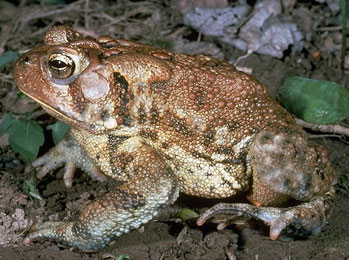Frogs & Toads
What is a frog?

Frogs are smooth skinned amphibians (means 'dual-life'). This refers to the 2 stages most frogs go through, firstly as aquatic tadpoles then metamorphosing in to air breating land animals. Other amphibians include salamanders and newts.
They change colour slightly to match their surroundings. The webbing on their feet does not extend to their toes. Frogs hop on land, and swim in a series of strong movements, using their powerful back legs to propel their body. They spend time around the pond or in the water during very warm weather, and can often be found at the base of water plants during sunny days.
Frogs and toads belong to the amphibian order 'Anura'. This means 'without tail'. There are over 4000 species in the order anura. All frogs have no tail apart from the tailed frog which does have a very small apendage that it retains throughout life.
The earliest known 'proto' frog dates from the Triassic period and is approximately 250 million years old. True frogs were in existence as long ago as the early Jurassic (see Geological Time) period, predating the appearance of most of the major dinosaur groups.
What is a toad?

A toad is also an amphibian like the frog. The most obvious difference between these two amphibians is their skin. Frogs have moist smooth skin, greenish brown to yellow in colour, with a distinctive brown patch behind their eyes. Toads have drier bumpier skin, which is often brownish and some even have poison glands that produce toxins.
Toads are predators, typically eating insects and small animals such as worms, slugs and snails. Prey is seized with the long sticky tongue, which is rooted at the front of the mouth. This can be extended by as much as 25mm.